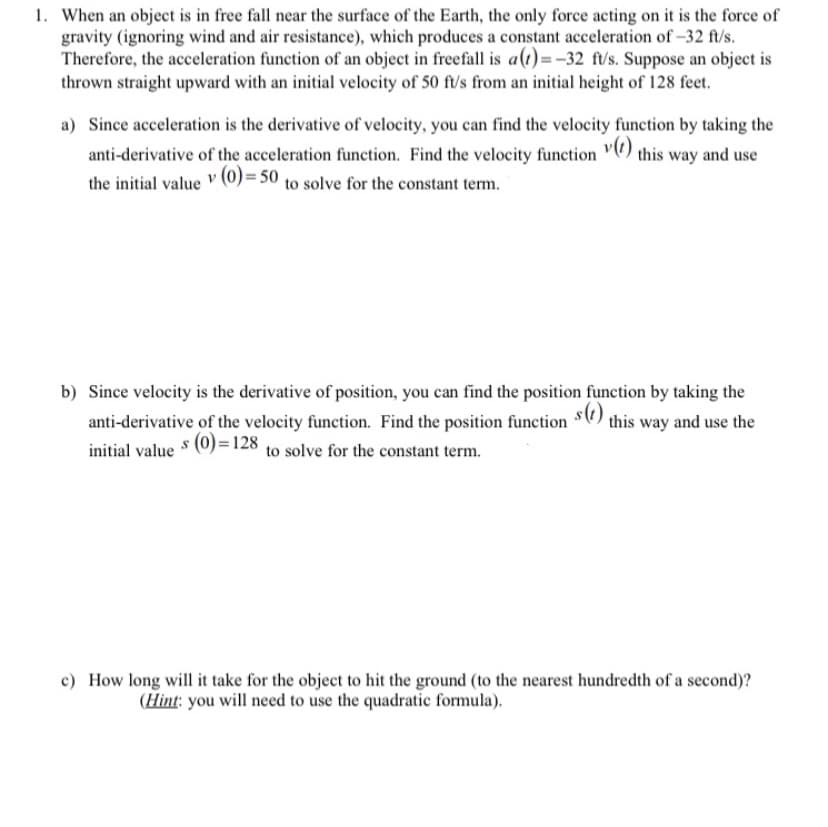1. When an object is in free fall near the surface of the Earth, the only force acting on it is the force of gravity (ignoring wind and air resistance), which produces a constant acceleration of-32 ft/s. Therefore, the acceleration function of an object in freefall is a(t)=-32 ft/s. Suppose an object is thrown straight upward with an initial velocity of 50 ft/s from an initial height of 128 feet. a) Since acceleration is the derivative of velocity, you can find the velocity function by taking the anti-derivative of the acceleration function. Find the velocity function ") this way and use the initial value v (0) = 50 to solve for the constant term. b) Since velocity is the derivative of position, you can find the position function by taking the s(1) this way and use the anti-derivative of the velocity function. Find the position function initial value $ (0)=128 to solve for the constant term. c) How long will it take for the object to hit the ground (to the nearest hundredth of a second)? (Hint: you will need to use the quadratic formula).
1. When an object is in free fall near the surface of the Earth, the only force acting on it is the force of gravity (ignoring wind and air resistance), which produces a constant acceleration of-32 ft/s. Therefore, the acceleration function of an object in freefall is a(t)=-32 ft/s. Suppose an object is thrown straight upward with an initial velocity of 50 ft/s from an initial height of 128 feet. a) Since acceleration is the derivative of velocity, you can find the velocity function by taking the anti-derivative of the acceleration function. Find the velocity function ") this way and use the initial value v (0) = 50 to solve for the constant term. b) Since velocity is the derivative of position, you can find the position function by taking the s(1) this way and use the anti-derivative of the velocity function. Find the position function initial value $ (0)=128 to solve for the constant term. c) How long will it take for the object to hit the ground (to the nearest hundredth of a second)? (Hint: you will need to use the quadratic formula).
Calculus: Early Transcendentals
8th Edition
ISBN:9781285741550
Author:James Stewart
Publisher:James Stewart
Chapter1: Functions And Models
Section: Chapter Questions
Problem 1RCC: (a) What is a function? What are its domain and range? (b) What is the graph of a function? (c) How...
Related questions
Question
Please help asap

Transcribed Image Text:1. When an object is in free fall near the surface of the Earth, the only force acting on it is the force of
gravity (ignoring wind and air resistance), which produces a constant acceleration of -32 ft/s.
Therefore, the acceleration function of an object in freefall is a(t)=-32 ft/s. Suppose an object is
thrown straight upward with an initial velocity of 50 ft/s from an initial height of 128 feet.
a) Since acceleration is the derivative of velocity, you can find the velocity function by taking the
anti-derivative of the acceleration function. Find the velocity function ") this way and use
the initial value (0)= 50 to solve for the constant term.
b) Since velocity is the derivative of position, you can find the position function by taking the
anti-derivative of the velocity function. Find the position function $C) this way and use the
s (0)=128 to solve for the constant term.
initial value
c) How long will it take for the object to hit the ground (to the nearest hundredth of a second)?
(Hint: you will need to use the quadratic formula).
Expert Solution
This question has been solved!
Explore an expertly crafted, step-by-step solution for a thorough understanding of key concepts.
This is a popular solution!
Trending now
This is a popular solution!
Step by step
Solved in 3 steps with 3 images

Recommended textbooks for you

Calculus: Early Transcendentals
Calculus
ISBN:
9781285741550
Author:
James Stewart
Publisher:
Cengage Learning

Thomas' Calculus (14th Edition)
Calculus
ISBN:
9780134438986
Author:
Joel R. Hass, Christopher E. Heil, Maurice D. Weir
Publisher:
PEARSON

Calculus: Early Transcendentals (3rd Edition)
Calculus
ISBN:
9780134763644
Author:
William L. Briggs, Lyle Cochran, Bernard Gillett, Eric Schulz
Publisher:
PEARSON

Calculus: Early Transcendentals
Calculus
ISBN:
9781285741550
Author:
James Stewart
Publisher:
Cengage Learning

Thomas' Calculus (14th Edition)
Calculus
ISBN:
9780134438986
Author:
Joel R. Hass, Christopher E. Heil, Maurice D. Weir
Publisher:
PEARSON

Calculus: Early Transcendentals (3rd Edition)
Calculus
ISBN:
9780134763644
Author:
William L. Briggs, Lyle Cochran, Bernard Gillett, Eric Schulz
Publisher:
PEARSON

Calculus: Early Transcendentals
Calculus
ISBN:
9781319050740
Author:
Jon Rogawski, Colin Adams, Robert Franzosa
Publisher:
W. H. Freeman


Calculus: Early Transcendental Functions
Calculus
ISBN:
9781337552516
Author:
Ron Larson, Bruce H. Edwards
Publisher:
Cengage Learning